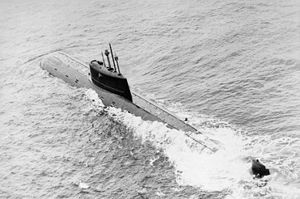Soviet submarine K-278 Komsomolets

K-278 Komsomolets profile
|
|

K-278, 1 Jan 1986
|
|
| History | |
|---|---|
| Name: |
|
| Builder: | Sevmash |
| Yard number: | 510 |
| Laid down: | 22 April 1978 |
| Launched: | 9 May 1983 (3 June 1983) |
| Commissioned: | 28 December 1983 |
| Decommissioned: | 6 June 1990 |
| Homeport: | Bolshaya Lopatka at Zapadnaya Litsa |
| Fate: | Sank due to fire on 7 April 1989, killing 42 |
| Status: | Located in the Barents Sea in 1,600 m (5,200 ft) of water with negligible release of radioactive material |
| General characteristics | |
| Class and type: | NATO reporting name "Mike"-class submarine |
| Displacement: | 4,400-5,750 tons surfaced, 6,400-8,000 tons submerged |
| Length: | 117.5 m (385 ft) |
| Beam: | 10.7 m (35 ft) |
| Draft: | 8 to 9 m (26 to 30 ft) |
| Propulsion: | One 190 MW OK-650 b-3 pressurised water reactor, two 45000 shp steam turbines, one shaft |
| Speed: | 14 knots (26 km/h; 16 mph) surfaced, 26 to 30 knots (48 to 56 km/h; 30 to 35 mph) submerged |
| Test depth: | 1,000 m safe, 1,250 m design, 1,500 m crush |
| Complement: | 33 officers, 21 warrant or petty officers, 15 enlisted |
| Armament: |
|
K-278 Komsomolets was the only Project 685 Plavnik (Плавник, meaning "fin", also known by its NATO reporting name of "Mike"-class) nuclear-powered attack submarine of the Soviet Navy. On 4 August 1984 K-278 reached a record submergence depth of 1,020 metres (3,350 feet) in the Norwegian Sea. The boat sank in 1989 and is currently resting on the floor of the Barents Sea, one mile deep, with its nuclear reactor and two nuclear warheads still on board. The single Project 685 was developed to test technologies for Soviet 4th generation nuclear submarines. Although primarily intended as a developmental model, it was fully combat capable, but sank after a fire broke out in the aft engineering compartment on its first operational patrol.
The Komsomolets was able to surface after the fire started and remained afloat for approximately 5 hours before sinking. Of the 42 crewmembers who died, only 4 were killed by the fire and smoke, while 34 died of hypothermia and drowning in the frigid waters while awaiting rescue that did not arrive in time. Because of this shocking loss of life a very public enquiry was conducted and, as a result, many formerly classified details were revealed by the Soviet news media.
The Project 685 was designed by the Rubin Design Bureau in response to a challenge to develop an advanced submarine that could carry a mix of torpedoes and cruise missiles with conventional or nuclear warheads. The order to design the submarine was issued in 1966 and design was completed in 1974. The first (and only) keel was laid down on 22 April 1978 at Severodvinsk. K-278 was launched on 3 June 1983 and commissioned on 28 December 1983.
K-278 had a double hull, the inner one being composed of titanium, which gave her an operating depth far greater than that of the best American submarines. The pressure hull was composed of seven compartments with the second and third protected by stronger forward and aft bulkheads creating a "safety zone" in case of an emergency. An escape capsule was fitted in the sail above these compartments to enable the crew to abandon ship in the event of an underwater emergency. Initial Western intelligence estimates of K-278’s speed were based on the assumption that it was powered by a pair of liquid-metal lead-bismuth reactors. When the Soviet Union revealed that the submarine used a single OK-650b-3 conventional pressurized-water reactor, these speed estimates were lowered.
...
Wikipedia
